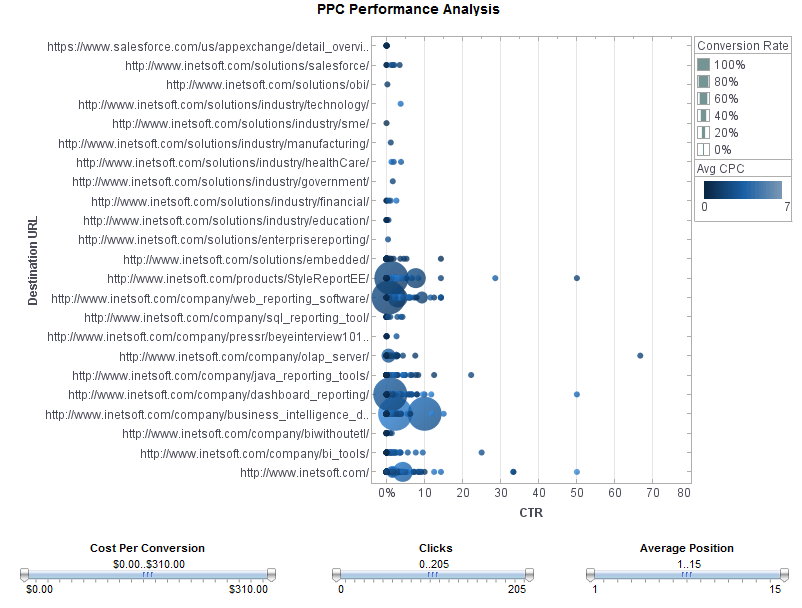100 Different Performance Management Software Packages
This is the continuation of the transcript of an in-person customer seminar hosted by InetSoft on the topic of "Ingredients for a Performance Management System to Succeed." The speaker is Christopher Wren, Principal Consultant at TFI Consulting.
There are over 100 different performance tracking software packages. So avoid this trap. Just because balanced scorecard is in the title doesn’t mean you are going to have a balanced scorecard, does it? A piece of software is not going to give you a balanced scorecard. Avoid this one, too. Just give it to the planning shop. It’s their job. Let them do it. Let them show us what they can build on their own, wrong answer.
Okay, quick success, early success should celebrated frequently. Remember what we are looking for here. Remember the objectives on the strategy map, cross out the word ‘objective’ and put “desired behavior changes” because that’s really what you are trying to get at here. You are trying to get at changing hearts and minds as a piece of your strategy, so that you can influence behaviors.
We like to use a little checklist to get people started thinking. We always start an engagement with something like this, here are those strategic components I have talked about with Mr. or Ms. CEO. Which one do you think is developed? Which one do you think is partially developed? Which ones haven’t you worked on, yet?
| #1 Ranking: Read how InetSoft was rated #1 for user adoption in G2's user survey-based index | Read More |
Find the Pain Point in Your Performance Tracking
This is sort of an eye opener for most folks when they go through it because a lot of times, they will put a lot of stuff over here, and then oh, my gosh, I never thought about this, or I really need organization values, and what’s this pain thing I have never thought about that. That’s always fun, folks, when you get into a workshop, and you ask the CEO what's wrong with this organization in front of his director, her direct reports, pause, dead silence, nobody wants to talk. So sometimes it takes a little while to break that ice. It’s good stuff.
This is the process of discovery. When we put these into the hopper here, the values and the customer needs and the pains and the demographics and the external environment, what we get out from the discussion with the key people is mission, vision, customer, value proposition and the perspectives. And that leads us then to organization strategy. Organization strategy at a high level is three or four strategic themes. That’s it, folks. It’s not six or 10 gold buckets so I can dump all the stuff I am currently doing in. It’s the pillars of excellence, what do we have to be world class, to be successful.
Don’t use organization structure as a strategy. You can’t just look down though a couple of different departments, and say, I am going to answer that. I mean you and I all know that strategy is more like the random walk theory where I have to get people involved in different parts of the organizations, even different nations, even different agencies, before I can come up with a comprehensive strategy to solve a problem.
| #1 Ranking: Read how InetSoft was rated #1 for user adoption in G2's user survey-based index | Read More |
Strategy Profile Charts
Here is the chart we would like to put together. I call it a strategy profile chart, and it’s got emphasis over here on the Y axis and strategy success factors on the X axis. This is Southwest Airlines, basically the only profitable airline in the United States for many years. Look at the difference between their strategy as indicated by the success factors and other major airlines, they are almost opposite. Everything is almost exactly opposite. Southwest Airlines broke the model for air traffic, and they used the balanced scorecard and a very aggressive team to break that model and come up with a new way of doing business, and the results speak for themselves.
So you want to try something fun. Use this as a way of plotting your organization and its success factors against your competition, against best in class, against best practices as we find it as a very helpful tool for doing that. Strategy is vertical thinking, here back to that question when do we get to the budget process, all right here.
In operations you have horizontal thinking. If I am an operations guy, it’s how much money you are going to give me, what are the deliverables I need to make and how long do I have to do it. So it deals with inputs and processes and outputs and outcomes. We can put our measurement stethoscope anywhere we need to to get useful information, useful performance information. And we need both, don’t we? We need strategic information, but we also need operational information.
| Previous: After the Balanced Scorecard |


